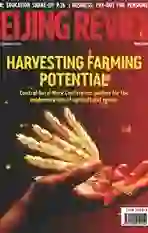Agricultural Renewal
2015-01-29
The Central Rural Work Conference held at the end of last year laid out plans to address issues concerning Chinas agriculture, farmers and rural areas in 2015 and beyond based on progress made in 2014. The meeting conveyed the message that promoting agricultural modernization by relying on reform and innovation will top the Chinese Governments agenda as it seeks to boost development in Chinas vast countryside.
China is traditionally an agricultural country. In recent decades, however, breakneck economic growth has led to dramatic changes in the countrys industrial and demographic structures. Chinas urban population exceeded its rural population for the first time in 2011, with the latter accounting for 46 percent of the total in 2013. Mindful of these changes, the Chinese Government is committed to modernizing the agricultural sector as part of its efforts to achieve balanced development across the country.
As the Chinese economy enters the“new normal” characterized by slow growth, problems facing rural areas have become increasingly serious. For example, agricultural resources are becoming scarce, the ecological environment in the countryside is deteriorating and contamination of rural land and water is exacerbating. Furthermore, as a large number of rural laborers migrate to cities, the aging of the rural population and scarcity of rural labor have become daunting challenges.
Chinas agriculture also faces competition from products from other countries. Chinese farmers enthusiasm for farming has been dampened by ever-rising production costs, decreasing prices of agricultural products in the international market, and the low contribution rate of technology to agriculture. In order to guarantee food security, the government has to encourage farmers to farm by offering subsidies.
Solving these pressing problems has been the focus of every years Central Rural Work Conference. The just concluded conference showed that a new round of rural reform has begun against the backdrop of the “new normal.” This round of agricultural reform is centered on ensuring food security and increasing rural residents income.
It is expected that the government will promote industrialized agriculture as well as its integration with other sectors of the economy in 2015. It will introduce sophisticated technology to farms and also continue to facilitate the transfer of land use rights to bolster large-scale farming.
Chinas reform process, which started in rural areas in the late 1970s, has fueled the countrys economic takeoff. It is hoped that the new initiatives will not only help modernize the countrys agricultural sector but also contribute to Chinas overall economic and social progress.
